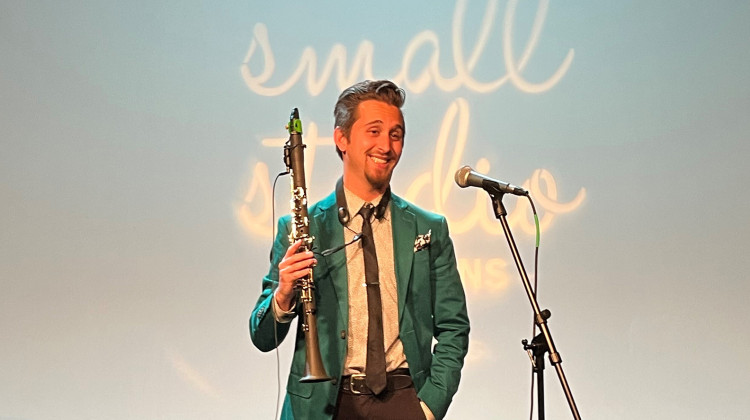The composer and clarinetist Eric Salazar describes his work as “newly composed” classical music. His recent solo performance for Small Studio Sessions included improvisation, digital effects, and a 3D printed clarinet. Salazar talked about his love for the instrument and his musical methods with WFYI's Kyle Long.
Kyle Long, WFYI: Eric, thank you for being here today.
Eric Salazar: Thank you for having me.
Long: Am I correct that you're here today playing clarinet because of the classic Hanna-Barbera cartoon Tom and Jerry?
Salazar: Yes, that is 100 percent true. Cartoons were one of the ways that I would become occupied after the school day when I was bouncing off the walls. I would sit in front of the TV, and Tom and Jerry was my favorite cartoon growing up. There's a lot of clarinet in the soundtrack. I just heard that sound, and I thought, “I want to do that.”
Long: Over the years, the clarinet has evolved in many different ways, and today, you have a 3D printed clarinet. Tell us about this instrument.
Salazar: Yes, I'm so excited about it. It's by Pereira 3D Clarinet Services, and the selling points for me on this instrument are that it is essentially crack proof, which is really important for a 21st century classical musician, because we're finding ourselves playing in spaces other than concert halls. So I'm outside, I'm at bars, and I've got to deal with a lot of temperature changes and humidity changes. So I know that this instrument is going to last and be reliable.
The other critically important thing is the price point. It is essentially a sixth of the price of competitor models, but it meets the same standards of professionalism. So that's what this is, the Pereira 3D Clarinet Services 3D printed clarinet.

Long: When you perform solo, you use a lot of digital effects. You have loop pedals, and all sorts of things going on. Tell us a bit about the technical side of what you're doing.
Salazar: Yes, I use a Boss RC-300 Loop Station. Essentially, the reason I went with this piece of equipment was because it has a lot of loops, and it has a multi-effects processor. So I can throw around distortion if I want, or a chorus effect, or a delay pedal.
Long: When I was in school, when we studied classical music, we learned about Bach, Beethoven, and Tchaikovsky. We learned about European and Russian men who were born hundreds of years ago. Well, today there are thousands of people of all ethnicities and genders, writing new symphonic music and chamber works. Collectively, this work is referred to as new music. Do you categorize what you do as new music? If so, how do you describe new music to a general audience?
Salazar: Yes, I fall under the category of new music. I'll also sometimes refer to it as new classical, or newly composed music. It's essentially a genre that is both carrying on the tradition of the classical music era, and also changing things to meet the requirements of our time here and right now. That's how I would describe it. It's newly composed music that is using some sort of system of notation of writing and reading music, but is meant to be in the aesthetic of modern society.
 DONATE
DONATE









 View More Programs
View More Programs



 Support WFYI. We can't do it without you.
Support WFYI. We can't do it without you.